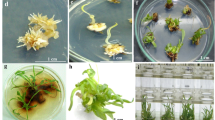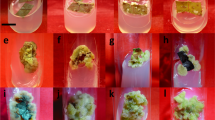Abstract
Explant oxidative browning and necrosis of Camellia sinensis var. sinensis is a severe problem in tissue culture, often associated with the exuded phenolic compounds and microbial contamination from the explants. In this study, 2-aminoindane-2-phosphonic acid (AIP), an inhibitor of the polyphenol production-required enzyme phenylalanine ammonia lyase (PAL), and different antibiotics were tested to control tea explant necrosis and browning. These compounds were supplemented in the regular plant growth medium together with 6-benzylaminopurine and thidiazuron at different concentrations. Our data indicated that application of 2 µM of AIP was able to effectively inhibit callus browning, significantly reduce EGC abundance, and greatly improve callus induction and growth. Moreover, the use of 150 mg/L of timentin and 30 mg/L gentamycin resulted in an effective elimination of the surface and endophytic microbes associated with explants of C. sinensis var. sinensis. Our study revealed that the inhibition of PAL using AIP combined with the two tested antibiotics could open up new doors to control oxidative tissue browning and endophyte contamination in tissue culture for tea genetic manipulation.



Similar content being viewed by others
References
Almajano MP, Carbó R, Jiménez JAL, Gordon MH (2008) Antioxidant and antimicrobial activities of tea infusions. Food Chem 108:55–63
Appert C, Zoń J, Amrhein N (2003) Kinetic analysis of the inhibition of phenylalanine ammonia-lyase by 2-aminoindan-2-phosphonic acid and other phenylalanine analogues. Phytochemistry 62:415–422
Ashihara H, Deng WW, Mullen W, Crozier A (2010) Distribution and biosynthesis of flavan-3-ols in Camellia sinensis seedlings and expression of genes encoding biosynthetic enzymes. Phytochemistry 71:559–566
Bagheri A, Marashi H, Moshtaghi N, Balandary A (2011) Investigation into seasonal effect and browning inhibitor on callus regeneration of seedless barberry (Berberis vulgaris var. asperma). Plant Tissue Cult Biotechnol 21:161–168
Beckman CH (2000) Phenolic-storing cells: keys to programmed cell death and periderm formation in wilt disease resistance and in general defence responses in plants? Physiol Mol Plant Pathol 57:101–110
Costa JMDWA, Mohotti JA, Madawala AW (2007) Ecophysiology of tea. Braz J Plant Physiol 19:299–332
Durner J, Shah J, Klessig DF (1997) Salicylic acid and disease resistance in plants. Trends Plant Sci 2:266–274
Eden T (1976) Tea. Longman Group Ltd, London
Enriquez-Obregon GA, Prieto-Samsonov DL, De La Riva GA, Perez M, Selman Housein G, Vazquez-Padron RI (1999) Agrobacterium-mediated japonica rice transformation: a procedure assisted by an antinecrotic treatment. Plant Cell Tissue Organ Cult 59:159–168
Forrest GI (1969) Studies on the polyphenol metabolism of tissue cultures derived from the tea plant (Camellia sinensis L.). Biochem J 113:765–772
Gamborg OL, Miller RA, Ojima K (1968) Nutrient requirements of suspension cultures of soybean root cells. Exp Cell Res 50:151–158
Graham HN (1992) Green tea composition, consumption, and polyphenol chemistry. Prev Med 21:334–350
Hahlbrock K, Scheel D (1989) Physiology and molecular biology of phenylpropanoid metabolism. Annu Rev Plant Physiol Plant Mol Biol 40:347–369
Han Z-X, Rana MM, Liu G-F, Gao M-J, Li D-X, Wu F-G, Li X-B, Wan X-C, Wei S (2016) Green tea flavour determinants and their changes over manufacturing processes. Food Chem 212:739–748
Harler CR (1964) The culture and marketing of tea. Oxford University Press, London
Janovitz-Klapp AH, Richard FC, Goupy PM, Nicolas JJ (1990) Kinetic studies on apple polyphenol oxidase. J Agric Food Chem 38(7):1437–1441
Jones AMP, Saxena PK (2013) Inhibition of phenylpropanoid biosynthesis in Artemisia annua L.: a novel approach to reduce oxidative browning in plant tissue culture. PLoS ONE 8(10):e76802. https://doi.org/10.1371/journal.pone.0076802
Karthikeyan A, Karutha Pandian S, Ramesh M (2011) Agrobacterium-mediated transformation of leaf base derived callus tissues of popular indica rice (Oryza sativa L. sub sp. indica cv. ADT 43). Plant Sci 181:258–268
Ke D, Saltveit ME (1989) Wound-induced ethylene production, phenolic metabolism and susceptibility to russet spotting in iceberg lettuce. Physiol Plant 76:412–418
Kerio LC, Wachira FN, Wanyoko JK, Rotich MK (2013) Total polyphenols, catechin profiles and antioxidant activity of tea products from purple leaf coloured tea cultivars. Food Chem 136:1405–1413
Krishna H, Sairam RK, Singh SK, Patel VB, Sharma RR et al (2008) Mango explant browning: effect of ontogenic age, mycorrhization and pre-treatments. Sci Hortic 118:132–138
Kumar N, Gulati A, Bhattacharya A (2013) l-Glutamine and l-glutamic acid facilitate successful Agrobacterium infection of recalcitrant tea cultivars. Appl Biochem Biotechnol 170:1649–1664
McEvily AJ, Iyengar R, Gross AT (1992) Inhibition of polyphenol oxidase by phenolic compounds. In: Ho C-T, Lee CY, Huang M-T (eds) Phenolic compounds in food and their effects on health I. ACS symposium series, vol 506. American Chemical Society, Washington, DC, pp 318–325
Mondal TK, Bhattacharya A, Sood A, Ahuja PS (1998) Micropropagation of tea (Camellia sinensis (L.) O. Kuntze) using thidiazuron. Plant Growth Regul 26:57–61
Murashige T, Skoog F (1962) A revised medium for rapid growth and bio-assays with tobacco tissue cultures. Physiol Plant 15:473–497
Nybakken L, Keski-Saari S, Falck MA, Julkunen-Tiitto R (2007) Restoration of secondary metabolism in birch seedlings relieved from PAL-inhibitor. Trees Struct Funct 21:273–281
Oh M-M, Trick HN, Rajashekar CB (2009) Secondary metabolism and antioxidants are involved in environmental adaptation and stress tolerance in lettuce. J Plant Physiol 166:180–191
Olhoft PM, Somers DA (2001) l-Cysteine increases Agrobacterium-mediated TDNA delivery into soybean cotyledonary-node cells. Plant Cell Rep 20:706–711
Osman MG, Elhadi EA, Khalafalla MM (2010) Callus formation and organogenesis of tomato (Lycopersicon esculentum Mill, C.V. Omdurman) induced by thidiazuron. Afr J Biotechnol 9:4407–4413
Panaia M, Senaratna T, Bunn E, Dixon KW, Sivasithamparam K (2000) Micropropagation of the critically endangered Western Australian species, Symonanthus bancroftii (F Muell.) L. Haegi (Solanaceae). Plant Cell Tissue Organ Cult 63:23–29
Parthasarathy VA, Keshavachandran R, Nazeem P, Girija D, John PS et al (2007) High tech propagation of horticultural crops-accent on recalcitrance. In: Recent trends in horticultural biotechnology, vols I and II. ICAE national symposium on biotechnological interventions for improvement of horticultural crops: issues and strategies. New India Publishing Agency, Vellanikkara, pp 85–91
Peiser G, Lo´pez-Ga´lvez G, Cantwell M, Saltveit ME (1998) Phenylalanine ammonia lyase inhibitors control browning of cut lettuce. Postharvest Biol Technol 14:171–177
Rana MM, Han ZH, Song DP, Liu GF, Li DX, Wan XC, Karthikeyan A, Wei S (2016) Effect of medium supplements on Agrobacterium rhizogenes-mediated hairy root induction from the callus tissues of Camellia sinensis var. sinensis. Int J Mol Sci 17:1132–1149
Sapers GM, Hicks KB (1989) Inhibition of enzymatic browning in fruits and vegetables. In: Jen JJ (ed) Quality factors of fruits and vegetables: chemistry and technology. ACS symposium series, vol 405. American Chemical Society, Washington, DC, pp 29–43
Sarathchandra TM, Upali PD, Wijewardena RGA (1988) Studies on the tissue culture of tea (Camellia sinensis (L.) O. Kuntze) 4 somatic embryogenesis in stem and leaf callus cultures. Sri Lanka J Tea Sci 57:50–54
Tamagnone L, Merida A, Stacey N, Plaskitt K, Parr A et al (1998) Inhibition of phenolic acid metabolism results in precocious cell death and altered cell morphology in leaves of transgenic tobacco plants. Plant Cell 10:1801–1816
Tanprasert P, Reed BM (1997) Determination of minimal bactericidal and effective antibiotic treatment concentrations for bacterial contaminants from micropropagated strawberries. In Vitro Cell Dev Biol Plant 33:227–230
Teklemariam TA, Blake TJ (2004) Phenylalanine ammonia-lyase induced freezing tolerance in jack pine (Pinus banksiana) seedlings treated with low, ambient levels of ultraviolet-B radiation. Physiol Plant 122:244–253
Tomás-Barberán FA, Gil MI, Castañer M, Artés F, Saltveit ME (1997) Effect of selected browning inhibitors on phenolic metabolism in stem tissue of harvested lettuce. J Agric Food Chem 45:583–589
Verberne MC, Mulijono RAB, Verpoorte R (1999) Salicylic acid biosynthesis. In: Hooykaas PPJ, Hall MA, Libbenga KR (eds) Biochemistry and molecular biology of plant hormones. Elsevier Science BV, Amsterdam, pp 295–314
Wang L, Yan X, Guo X, Zhang R, Mei Y, Wei C (2016) Diversity of endophytic microorganisms in Zijuan and Yunkang 10 of Camellia sinensis. J Anhui Agric Univ 43:1–6
Xu K (2013) An overview of Arctic apples: basic facts and characteristics. N Y Fruit Q 21:8–10
Acknowledgements
The authors thank the National Natural Science Foundation of China (Grant numbers 31070614 and 31370687) and the Research Fund for the Doctoral Program of Higher Education (20123418110002).
Author information
Authors and Affiliations
Contributions
KA and LFS conducted the experiments and prepared the manuscript; SW provided critical suggestions over the study and finalized the manuscript.
Corresponding author
Ethics declarations
Conflict of interest
The authors declare that they have no conflict of interest.
Rights and permissions
About this article
Cite this article
Alagarsamy, K., Shamala, L.F. & Wei, S. Influence of media supplements on inhibition of oxidative browning and bacterial endophytes of Camellia sinensis var. sinensis. 3 Biotech 8, 356 (2018). https://doi.org/10.1007/s13205-018-1378-9
Received:
Accepted:
Published:
DOI: https://doi.org/10.1007/s13205-018-1378-9




